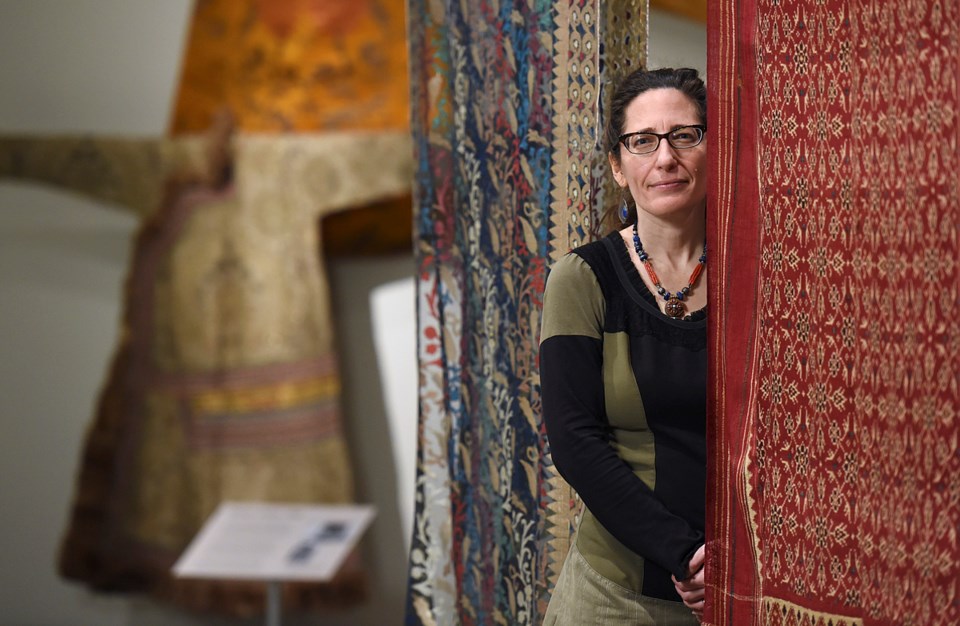To the untrained eye, it looks like an ordinary blanket. A beautiful one, certainly, crafted by hand with care and precision. But for the Musqueam people, the blanket is a symbol of the power vested in an individual by the community.
For a leader, like an elected band chief, going into the world as a representative of their community, the blanket represents communal responsibility. It can also be much more. If a person is in a vulnerable state, if they are ill or going through a rite of passage, they will be wrapped in the blanket as an expression of comfort and protection. Or they will be seated on a stack of blankets. Or stood on a blanket. Â
The symbolism is so rich, yet so obvious: What is more comforting than being wrapped in a blanket? Whether newly born or nearing death, ill with a common cold or simply tired after a long day, a blanket is a welcoming source of protection and comfort. The political and spiritual significance invested in blankets by the Musqueam and many other First Nations is typical of a global phenomenon. Human beings imbue sacred meaning into items of everyday use.
Examples of this from around the globe are on display now at the Museum of Anthropology, and the parallels are striking regardless of continent. The exhibit, Layers of Influence, highlights some of the MOA’s most stunning textile artifacts. While the museum is most known for items such as totem poles, of the approximately 40,000 items in the museum’s collections, about 6,000 are categorized as textiles.
Jennifer Kramer, an associate professor in UBC’s anthropology department as well as a curator of the Pacific Northwest for the MOA, explains that textile items are difficult to display because they can deteriorate in light. However, the curators collectively decided it was time for a major show of these items, and Kramer curated it. The intention, when you walk into the O’Brian and Audain Gallery, is to feel enveloped in the colourful and detailed fabrics hanging from the ceilings.
In almost every culture on earth, Kramer says, some level of spirituality is invested in articles of clothing. There is special garb worn by clergy, and designated outfits for rites of passage, such as christenings, marriage, even death. Observant Muslims, Jews, Sikhs, Zoroastrians,
Mormons and many other religious groups have identifying articles of clothing. Is there any culture or tradition for which clothing does not have some significance, I ask?
“I don’t think so,” she replies. Even when the article of clothing is a rejection of materialism, there is deep meaning imbued in that choice. Consider Gandhi: He wore the plainest garment of cotton, handwoven in traditional and simple Indian style, a rejection of British wealth, colonial trade and imperial power.
Almost universally, Kramer says, clothing represents pride, power, prestige and protection: Pride in one’s identity, with clothing frequently expressing membership in a group; Power, vested in an individual through such things as a pope’s mitre or a mayor’s chain of office; Prestige, whether walking the red carpets of Hollywood or a smalltown Main Street, is demonstrated through clothing choices; and Protection, which has multiple meanings, including the one that led me to Kramer.
“Spiritual protection and connection to the spiritual,” she says, is realized through textiles in many different ways, but is almost universally practised.
“Each culture, of course, does it in specific ways,” she adds, but all cultures have some approach to textiles that either embraces or borders on a connection to the divine, however they think about their cosmological beliefs.
Looking at one especially ornate piece of weaving, and knowing that, before the weaver crafted the item, they first spun the wool through the most ancient of practices by running their hand over their thigh with the animal fleece between them, Kramer speculates that the craftsperson had to have been in some sort of meditative state.
In other cases, the religiosity is more overt.
The riga, a Muslim man’s robe of honour from the Hausa people of Nigeria, has explicitly Islamic designs and, in some cases, would have prayers or Koranic verses embroidered inside the garment.
“He’s wearing his belief system to protect him,” Kramer says. In addition to the religious imagery and messaging built into the clothing, in many instances, the handiwork would be done by a Koranic scholar, whose prayers while he works add to the sacredness of the article.
One culture believes that weaving is best practised in springtime, when the overall sense of fertility and creation is at its peak.
“It’s as if the weaving connects to the cosmological cycles,” she says.
As different as we may be, and the world today seems intent on emphasizing differences over similarities, it is notable that across all cultures, we make existential and spiritual statements through our choices of what we wear.
“We get wrapped in cloth from birth to death and they are significant for rites of passage,” Kramer says, “And even though what we are wrapped in is totally different — it may be bark cloth, it may be silks, it could be dyed with indigo — but the idea is of protecting yourself in clothing.”
@Pat604Johnson



